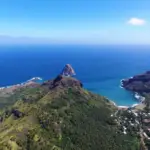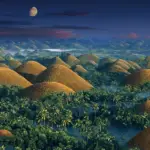
THE Kalahari Desert is one of the landscapes most surprising and fascinating in the world, with unforgettable stories that have been told for generations. This desert, located in southern Africa, covers more than 900,000 km² of dry land and is home to a wide variety of wildlife and indigenous cultures.
Prepare to be transported on a unique adventure as we explore this remarkable desert.
Main Conclusions:
- THE Kalahari Desert It is a stunning landscape covering more than 900 thousand km².
- This desert is home to a wide variety of wildlife and indigenous cultures.
- THE Kalahari Desert is known for its fascinating and unique stories that have been passed down through generations.
- Prepare to embark on an extraordinary journey as we discovered the secrets of this remarkable desert.
Introduction to the Kalahari Desert
The Kalahari Desert is a place full of surprises, from its immensity to its characteristics unique features that make it a true natural treasure. Located in Southern Africa, this desert is one of the largest continuous sand areas in the world, covering over 930,000 square kilometers.
Furthermore, the region stands out for its rock formations, vast golden plains and for being home to a rich variety of life wild, becoming a unique destination for tourists looking for a different experience.
But much more than a tourist destination, the Kalahari Desert is an area of great ecological importance, serving as home to diverse species plants and animals, many of which are found only in this region.
With your location strategic, this desert is a true oasis in the heart of the African continent, attracting people from all over the world in search of unforgettable adventures and surprising stories.

Life in the Kalahari Desert
The Kalahari Desert is a challenging environment for wildlife, yet many species have managed to adapt and thrive in this region. From large mammals to tiny insects, life in the desert is surprisingly diverse.
One of the most famous animals of the Kalahari Desert is the meerkat, the small and charismatic creature that has captured hearts around the world. These small animals have a number of adaptations to survive in the desert, such as large eyes to see predators at long distances and powerful front paws to dig their burrows in search of food and shelter. Furthermore, meerkats live in groups, which helps ensure their safety and divide daily tasks.
Others species Animals found in the Kalahari Desert include lions, leopards, jackals, and hyenas, which search for prey in the region's plains and savannas. Birds such as ostrich and vulture also inhabit the desert, as do reptiles such as lizards and snakes.
To survive in the desert, these species have developed a series of adaptations impressive. Some creatures, like the oryx, have long legs that allow them to run at high speeds when necessary, while others, like chameleons, change color to blend in with their surroundings. Some desert animals, like the warthog, can survive without water for long periods of time, getting all the moisture they need from the succulent plants they eat.
Overall, the wildlife of the Kalahari Desert is fascinating and full of surprises. If you ever get the chance to visit this region, don't miss the opportunity to observe some of the most interesting and adapted species on the planet up close.

Culture and Peoples of the Kalahari Desert
The Kalahari Desert is home to several indigenous peoples, including the San culture, who have a strong connection to the region. The San are known for their skill in hunting and gathering food in the challenging desert landscape. Their traditions and lifestyle are deeply rooted in nature and the resources it offers.
THE San culture is one of the oldest in the world. They believe in a creator deity, known as Kaggen or Khu, who is responsible for the activities of nature. Belief in ancestral spirits is also fundamental to their culture. The San believe that the spirits of their ancestors can help them hunt, cure illnesses, and even predict the weather.
THE music and dance are essential elements of culture San. During their ceremonies, special dances are performed that tell stories about their traditions and beliefs. The music is made with handmade instruments, such as musical bows and goatskin drums.
The San have a rich oral tradition, and many stories and legends are passed down from generation to generation. Some of these stories tell of how animals were raised and how the San learned to survive in the desert. Other stories are used to teach lessons about life and morality.
Respect for culture and sustainability
When visiting the Kalahari Desert, it is important to show respect for the San culture and others. indigenous peoples of the region. This includes respecting their traditions and learn about their stories and beliefs. Furthermore, it is essential to adopt practices of sustainable tourism that minimize the environmental impact and help preserve the region for future generations.

Adventures in the Kalahari Desert
If you are looking for adventure and contact with nature, the Kalahari Desert is the perfect place. With a surprising landscape and a rich and diverse wildlife, there are many options for tourism and activities to choose from.
Safaris
One of the best ways to explore the Kalahari Desert is on safari. Expert guides can take you to the best spots to see animals like lions, elephants, and zebras, as well as explain more about the region's wildlife.
Hiking and trails
For those who like activities outdoor, walking through the desert is an unmissable option. There are trails for all skill levels, with incredible views of the sand dunes, canyons, and the sunset over the savannah.
Bike tours
Another popular option is a desert bike tour, where you can explore more remote and even more scenic areas than on safari. Guided tours are available and can be tailored to your skill level and interests.
Camping
For a more authentic experience, you can camp in the Kalahari Desert. Finding an approved site and having an experienced guide is essential, but the reward is the chance to admire nature up close and experience desert life day and night.
Whatever your chosen adventure, always remember to respect nature, avoid littering, and follow local rules and regulations. This way, you can enjoy all the Kalahari Desert has to offer safely and responsibly.
Climate and Landscapes of the Kalahari Desert
The Kalahari Desert is a region marked by a climate arid and inhospitable, with temperatures that can vary from very high during the day to very low at night. Rainfall is scarce and irregular, which contributes to the formation of vast areas of sand dunes.
To the landscapes of the Kalahari Desert are truly amazing. In addition to the sand dunes, it is possible to find immense plains and mountains, as well as a wide variety of flora and fauna adapted to the extreme conditions of this region.
Sand Dunes
The sand dunes are one of the highlights of the landscapes of the Kalahari Desert. They can be hundreds of meters high and move constantly, shaped by the winds that blow through the region.
In some areas, it is also possible to find fossilized dunes, which reveal the geological history of the desert.
Plains and Mountains
Beyond the sand dunes, the Kalahari Desert features vast areas of plains and mountains that offer beautiful scenery. Some higher elevations are even home to forests and seasonal streams, which come alive with occasional rains.
The combination of mountains and plains offers a fascinating contrast, creating a unique and memorable landscape.

Flora and Fauna
The flora and fauna of the Kalahari Desert have adapted to the region's extreme conditions. For example, you'll find trees and shrubs that store water in their roots and stems, as well as a wide variety of animal species that have developed clever strategies to survive the lack of water and food.
Among the animal species that inhabit the Kalahari Desert are lions, leopards, hyenas, jackals, elephants, rhinos, antelopes, and many others. Some of these animals can be spotted during safaris and tours in the region.
The landscape of the Kalahari Desert is unique and fascinating, offering an experience of unforgettable trip for those who exploit it.
Preservation and Sustainability in the Kalahari Desert
The Kalahari Desert is a unique and valuable region, and it is essential to preserve its natural beauty and wildlife diversity for future generations. The environmental preservation and the sustainability are essential to maintain a healthy balance between human activities and nature.
There are several conservation projects implemented in the Kalahari Desert to protect local flora and fauna and reduce the impact of human activities on the region. These projects range from environmental education to the application of sustainable practices in agricultural activities. tourism and economic development.
Among the conservation projects One of the best-known initiatives in the Kalahari Desert is Green Kalahari, an initiative that aims to combat environmental degradation and promote the restoration of degraded areas through the conservation of natural resources and environmental awareness. Furthermore, many reserves and national parks in the region have similar projects, which aim to both conserve biodiversity and promote sustainable tourism.
It is also important to emphasize that the respect for culture and to the indigenous peoples that inhabit the Kalahari Desert is essential for the preservation of the region's landscape and ecosystems. The implementation of responsible tourism practices that take into account the impact environmental and the local culture, is the key to sustainable and lasting development.
If you are planning to visit the Kalahari Desert, remember the importance of preserving the landscape and supporting conservation initiatives and sustainability. Do your part and contribute to maintaining this spectacular region for future generations.
Myths and Legends of the Kalahari Desert
The Kalahari Desert is rich in myths and legends that capture the imagination. For the indigenous peoples who have inhabited the region for thousands of years, mythology is an intrinsic part of their culture and tradition.
One of the legends The best-known is the Sun Snake, which is revered as one of the creators of the world. According to legend, the earth was dark and cold until the Sun Snake appeared and brought heat and light to warm the world.
Another popular legend is that of Kaa, also known as "the spirit of evil." According to belief, Kaa is responsible for causing misfortune and unhappiness in people's lives. Indigenous peoples often perform rituals to ward off Kaa and ensure good luck and protection.
In addition to these legends, many other fascinating stories are told about the Kalahari Desert. Explore the rich mythology and desert culture and discover the beliefs passed down from generation to generation.
Responsible Tourism in the Kalahari Desert
The Kalahari Desert is a unique and sensitive region, and it is important that tourists understand the impact of their visits. To enjoy the tourism in a sustainable way, it is necessary to respect the culture and minimize the environmental impact.
One of the ways to promote the sustainable tourism in the Kalahari Desert is to choose tour operators that take the environmental preservation and cultural. Research before booking a trip and choose companies that have a clear commitment to sustainability.
Additionally, respect the local culture during your visit. Learn about the traditions and customs of the region's indigenous people and be a respectful visitor. Avoid behavior that could be considered offensive or invasive.
It's also important to minimize your environmental impact during your visit. Keep all your trash and don't leave anything behind. Avoid single-use plastics and opt for reusable bottles. If possible, choose accommodations that adopt sustainable practices, such as rainwater harvesting and solar energy.
Responsible tourism in the Kalahari Desert is a way to preserve the region for future generations and ensure that the beauty and diversity of its wildlife continues to tell stories forever.

Conclusion
In this final section, let's revisit the incredible stories and adventures that the Kalahari Desert has to offer. We hope you've been enchanted by this surprising landscape and for the unforgettable whispers it holds.
You learned about the characteristics features of this desert, its ecological importance, the rich diversity of wildlife, the cultures and traditions of indigenous peoples, and the countless activities you can enjoy during your visit.
We discovered how the climate of the Kalahari Desert shapes the stunning landscapes, including the famous sand dunes, and how the environmental preservation and sustainability are fundamental to protecting this unique region.
We also explore the wealth of myths and legends surrounding the Kalahari Desert and how tourism can be enjoyed responsibly and sustainably, with respect for culture local and minimizing environmental impact.
Finally, we hope you're excited for an extraordinary journey into the Kalahari Desert. Prepare for a captivating adventure, with unforgettable stories waiting to be discovered.
FAQ
Where is the Kalahari Desert located?
The Kalahari Desert is located primarily in southern Africa, encompassing parts of Namibia, Botswana, and South Africa.
What are the distinctive features of the Kalahari Desert?
The Kalahari Desert is known for its vast plains, red dunes, and sparse vegetation. It is a semiarid desert that is home to a surprising diversity of wildlife and species adapted to extreme conditions.
What species can be found in the Kalahari Desert?
In the Kalahari Desert, you can find a variety of species, including lions, elephants, black rhinos, meerkats, zebras, and unique birds such as the white-headed vulture.
How have animals adapted to the Kalahari Desert?
The species that inhabit the Kalahari Desert have developed adaptations remarkable for surviving challenging conditions, such as the ability to store water for long periods and characteristics special physical features, such as wide paws for walking on sand dunes.
What are the traditions of the indigenous peoples of the Kalahari Desert?
The indigenous peoples of the Kalahari Desert, such as the San, have a rich culture and traditions passed down from generation to generation. They are known for their hunting skills, survival techniques, and deep knowledge of the land and nature.
What outdoor activities can I enjoy in the Kalahari Desert?
In the Kalahari Desert, you can enjoy thrilling safaris, 4x4 drives, guided walks, birdwatching, quad biking, and much more. There are options for all tastes and ages.
What is the climate like in the Kalahari Desert?
The Kalahari Desert has a climate Semi-arid, and temperatures can vary greatly, with intense heat during the day and cold at night. Rainfall is also limited, contributing to the dry landscape.
What are conservation projects in the Kalahari Desert?
You conservation projects in the Kalahari Desert aim to protect wildlife and the region's unique ecosystem. They work to preserve the species' natural habitat and promote environmental sustainability.
What are the myths and legends related to the Kalahari Desert?
The Kalahari Desert is surrounded by myths and legends passed down by indigenous peoples. These stories tell of mythical creatures, spirits, and ancestral teachings, adding an element of mysticism to the region.
How can I enjoy Kalahari Desert tourism responsibly?
To enjoy tourism in the Kalahari Desert responsibly, it is important to respect the local culture, follow the guides' instructions, avoid disturbing wildlife, and minimize environmental impact by not leaving trash behind.
Lucas Wanderlust has a tireless spirit of adventure, always seeking new travel experiences. Fascinated by the world and the possibility of exploring unknown destinations, he fell in love with the sense of freedom and self-discovery that traveling alone provides. With a backpack on his back and a heart open to the unknown, Lucas embarks on exciting journeys, where each destination becomes a unique chapter in his life story. He gives himself body and soul to the magic of solo travel, inspiring others to follow in his footsteps and discover themselves through adventure.







